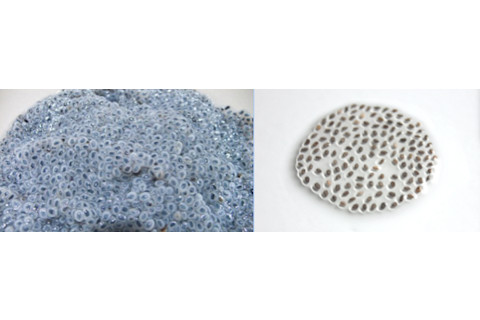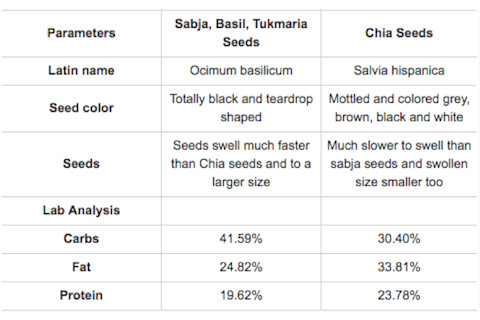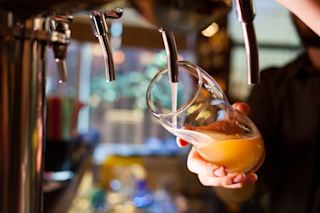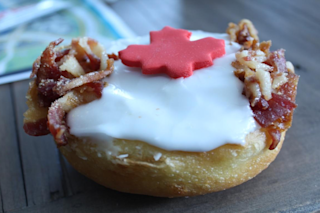Guest post by Nessa Riazi
Bustling with delighted customers unwrapping banana leaves to discover hidden curries and stewed meats, Indonesian restaurant Simpang Asia is a gastronomic awakening; its market next door is another. My sister recently introduced me to this restaurant nestled in Palms that is now my favorite Indonesian restaurant in LA. The best part is that as you wait for your table, you are able to explore and happily distract yourself in the aisles of the eclectic supermarket next door. During my quest to find a new ingredient to experiment with in my daily cooking endeavors, I came across dried basil seeds, or mangluck in Thai.
Binomially they are called Ocimum basilicum, coming from the sweet basil plant. Not having reached the same level of mainstream popularity in the culinary world as chia seeds, or Salvia hispanica L., could basil seeds potentially be the next chia seed? Their unique genus may suggest that more differences exist; however, based solely on physical observations and their reactivity to water, basil and chia seeds seem closely related. How do these seeds compare?

basil-chia-seeds
Dry Basil seeds (left) and chia seeds (right) | Photocred: thenaturalhealthmarket
One of the most defining features of chia and basil seeds is that when in contact with water, both swell up into gelatinous pearls. The layer of mucilage formed is not only safe to consume, but it is associated with soothing abilities for one’s digestive tract, sealing the mucous membranes and acting as a barrier to irritation of nerve endings [7]. Mucilage is a polar glycoprotein that is texturally characterized by a dense stickiness, and it can be found in a number of plants such as aloe vera, psyllium husks, and okra. It has been known since ancient times to have medicinal benefits [5].

Basil seeds after immersion in water | photocred: Hubpages and Chia seeds after immersion in water | photocred: chiaseedinwater
Basil seeds predominated throughout India and other parts of Southeast Asia as well as Iran and Africa [4]. Closely resembling black sesame seeds in appearance, they are extracted from the popular basil plant. Basil seeds go by several other names such as sabja or tukmaria in Hindi and falooda in Arabic. When soaked in liquid, their pericarp or outer epidermis expands into a gelatinous bubble of a beautiful purple-greyish color. Unlike chia seeds, they are not to be eaten raw. Basil seeds have been used for both medicinal and culinary purposes. For example, it is said that traditional Persian herbalists administered soaked basil seeds to help with coughs, asthma, or colds due to their antispasmodic effects [2]. Basil seeds have also been used for digestive issues such as constipation, as well as for alleviating stress levels and depression [9]. In addition to their benefits for the digestive system, basil seeds have a high iron content, supplying 40 percent of one’s RDA per 100 grams (3.17 mg per 100 mg). Being a key ingredient to rose-water infused beverages such as Persian faloodeh or Thai nam manglak, basil seeds can create a nice refreshing drink when combatting hot weather [3]. Talk about food and functionality!

Chia seeds—one of the more popular items in the current food market and a so-called “superfood”—look almost like miniature dinosaur eggs. In attempting to bite down on these tiny seeds, it seems as though the mouthfeel of chia is characterized by a crisper pop, while basil seeds are squeakier and take on a more tapioca-like texture due to the enlarged, thicker pericarp.This latter seed similarly puffs up when immersed in water–due to the hydrophilic nature of its soluble-fiber seed coat– though it has a longer expansion time. Chia’s soluble fiber is a large contributor to its hydrophilic quality because as these soluble fibers dissolve in water, they absorb water to create the characteristic gelatinous pericarp [1]. Interestingly, chia seeds can absorb anywhere up to 12 times their weight! Due to their high absorption of liquid, they help keep the body hydrated [8]. The gel that forms around the seed coat acts as a barrier between the digestive enzymes and carbohydrates, which in turn slows down the rate at which the carbohydrates are turned into sugar. As a result, blood sugar levels can be regulated, helping to lessen the risk for diabetes.
Chia seeds are an even better source of calcium—containing 3 to 6 times the amount found in milk. Per 100 gram, chia seeds contain, 631 mg of calcium, 7.72 g of Iron, 860 g of phosphorous and 23.665 g of polyunsaturated fatty acids [8]. While both seeds are good sources of iron, chia seeds contain approximately 4.55 mg more of iron. Shown by the table above, chia seeds are higher in protein by 4.16% and fat by 8.99%. Possessing tryptophan—the infamous “turkey” amino acid– which is converted into serotonin, melatonin, and dimethyltryptamine, chia seeds are also supposed to induce good sleep. The absorptive characteristic of the chia seed is induced by tiny micro-fibers standing on the surface of its shell, which draw in the liquid [6]. In its dried form, chia seeds are similar in size to basil seeds, but when wet, the gelatinous shell formed does not nearly reach the girth of that surrounding basil seeds. The texture provided by chia seeds have won them much favoritism amongst food experimenters as individuals incorporate them in homemade jams to add a desired level of viscosity and thickness.
Interested in learning more about the innovative ways to use chia in your everyday culinary affairs? Read Science and Food article “Chia Seed Apple Pie” to see how chia seeds can be used to create the perfect viscous pie filling. If you’re feeling daring, try making it with basil seeds!
References:
[1] Chia “Superfacts” Infographic: The Hydrophilic Super Seed. (2014). Health Warrior. http://www.healthwarrior.com/chiahydrophilic/. Accessed 5 September 2016.
[2] Dr. Nancy. (2011). Five Amazing Benefits of Basil (Sabja) Seeds. TrueNHealth. http://truthnhealth.com/2011/10/5-amazing-benefits-of-basil-seeds/. Accessed 20 August 2016.
[3] Falkowitz, Max. “Spice Hunting: Chewy Drinks with Basil Seeds.” Serious Eats. http://www.seriouseats.com/2011/04/spice-hunting-basil-seed-beverage-falooda-faluda-nam-manglak-drinks.html. Accessed 5 September 2016.
[4] Kintzios, Spiridon and Olga Makri. (2008). Ocimum sp. (Basil): Botany, Cultivation, Pharmaceutical Properties, and Biotechnology. Journal of Herbs Spices & Medicinal Plants. 13(3):123-150. http://www.researchgate.net/publication/239314732_Ocimum_sp_Basil_Botany_Cultivation_Pharmaceutical_Properties_and_Biotechnology. Accessed 5 September 2016.
[5] Segura Campos, M. R. (2014). Chemical and Functional Properties of Chia Seeds (Salvia hispanica L.) Gum. http://www.hindawi.com/journals/ijfs/2014/241053/. Accessed 20 September 2016.
[6] My Seeds Chia Hydration: Amazing Soluble Fiber. MySeeds Chia. http://www.mychiaseeds.com/articlehydration.htm. Accessed 19 September 2016.
[7] Gums and Mucilages. Herbs2000. http://www.herbs2000.com/h_menu/gums_mucilages.htm. Accessed 20 September 2016.
[8] S. Jolly, Rajan. (2016). Benefits of Chia Seeds and How They Differ from Basil Seeds. CalorieBee. http://caloriebee.com/nutrition/Some-Amazing-Benefits-Of-Chia-Seeds. Accessed 24 September 2016.
[9] S. Jolly, Rajan. (2015). Sweet Basil, Sabja or Tukmaria Seeds And Their Health Benefits. HubPages. http://hubpages.com/health/Sweet-Basil-Herb-Sabja-Or-Tukmaria-Seeds-And-Their-Health-Benefits. Accessed 24 September 2016.











